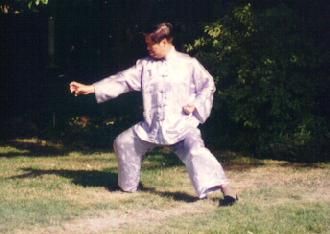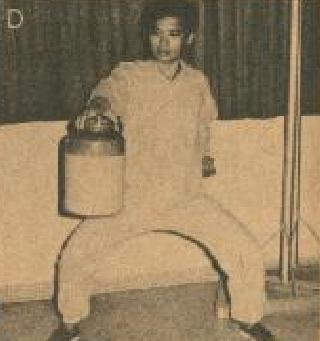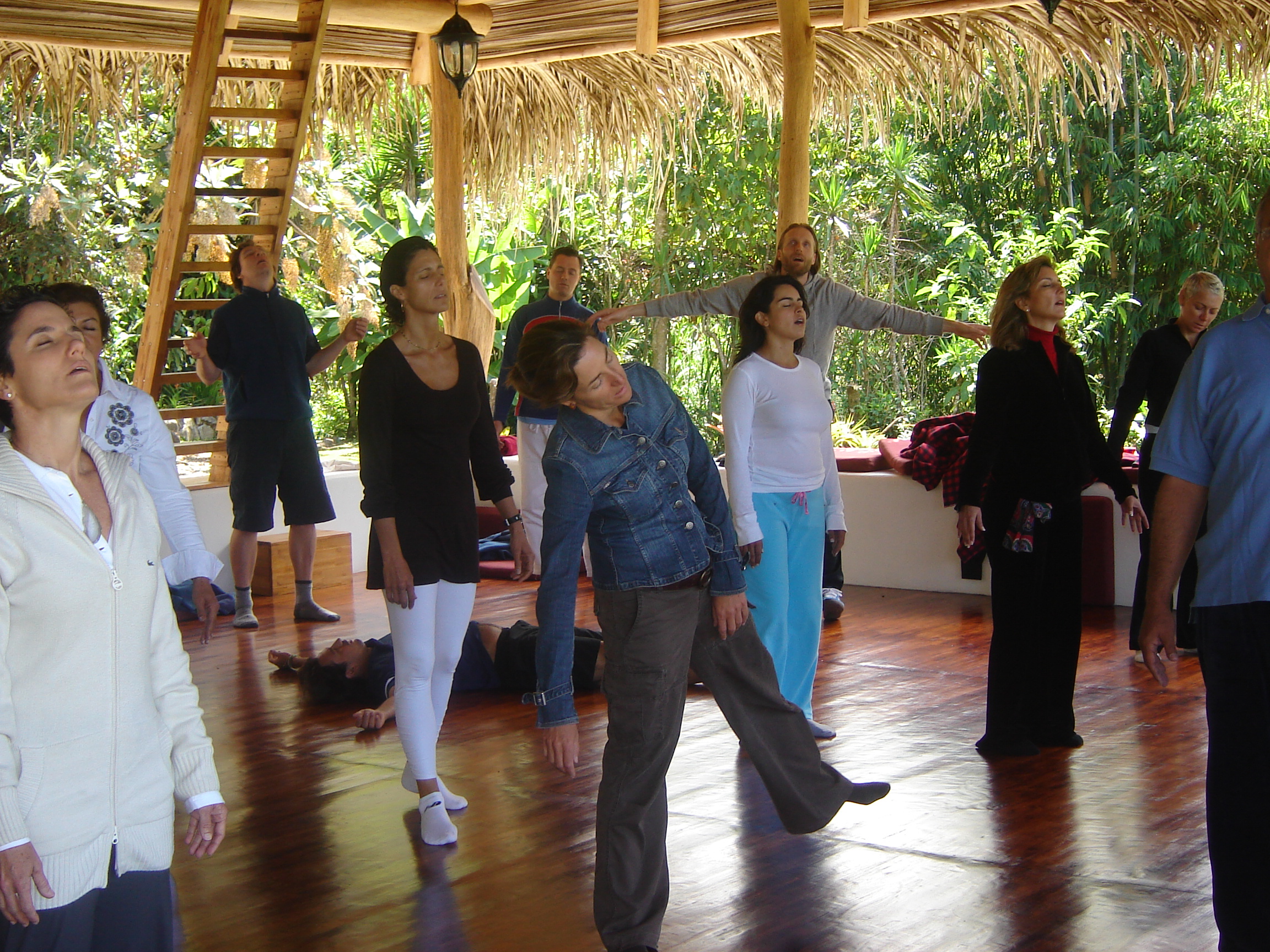SELECTION OF QUESTIONS AND ANSWERS
JULY 2013 PART 2

An internal method to train Tiger Claw
Question 1
Sifu, can you please tell us the difference between internal martial art training and external martial art training?
— Sifu Eugene Sittaman, USA
Answer
Thank you for asking this question. Eugene knows the answer. He is asking it for the benefits of some martial artists here.
A kungfu saying, "noi lin jing shen hei, ngoi lin khern khut pei" (Cantonese pronunciation), describes the difference between internal martial art training and external martial art training. The saying means that in internal arts, practitioners train essence, mind and energy, whereas in external arts, practitioners train tendons, bones and flesh.
When you perform our leg exercises in the Art of Flexibility gently and gracefully, for example, you train essence. When you stand upright in meditation, you train mind. When you regulate your breathing in Lifting the Sky, you train energy.
The classification into essence, mind and energy is for convenience and emphasis. In internal art training, all these three internal elements are involved. When you perform the Art of Flexibility, your mind is focused and your breathing gentle and natural. When you perform standing meditation, your body is relaxed and your breathing natural. When you perform Lifting the Sky, your movement is graceful and your mind focused.
In external art training, when you perform push-ups, you train your tendons. When you hit a pole with your arms, you train your bones. When you hit yourself to condition your body, you train your flesh.
The classification into tendons, bones and flesh is for convenienve and emphasis. In external art training, all these external elements are involved. When you perform push-ups, you also train your bones and flesh. When you hit a pole, you also train your tendons and flesh. When you condition your body, you also train your tendons and bones.
All other non-kungfu martial arts, like Karate, Taekwondo, Boxing, Kick-Boxing, Muay Thai and Wrestling, are considered external. Jiujisu and Aikido, though soft, are also considered external arts.
Amongst kungfu styles, Wing Choon, Choy-Li-Fatt, Hoong Ka, Wuzuquan, Eagle Claw, Tantui, Praying Mantis and Shaolin are considered external. Taijiquan, Baguazhang and Xingyiquan are considered internal.
This classification of kungfu styles into external and internal is by public opinion and is not accurate. As I have sometimes said, there are more internal aspects in Shaolin Kungfu than in Taijiquan, Baguazhang and Xingyiquan put together. The Wuzuquan I learned from Sifu Chee Kim Thong is very internal.
We in Shaolin Wahnam are very special. We can perform any kungfu styles, or even any martial arts, as internal training or external training. For example, we can perform Wing Choon Kungfu as an internal art. (In fact this is what we do. We do not, for example, hit sand-bags or strike wooden man, but develop internal force from Siu Lin Tou.) On the other hand, we may, for fun, perform Taijiquan as an external art. We can do this because of our wide range of skills and understanding of kungfu philosophy.
In terms of benefits, internal training is versatile, whereas external training is localized. For example, the internal force from Golden Bridge, which is a training of essence, can be used in any part of the body for combat, as well as contribute to health, vitality, longevity, mental clarity and spiritual joys. The external force from Iron Palm, which is a training of flesh, is localized at the palms, and does not contribute to health, vitality, longevity, mental clarity and spiritual joys.
Internal art training is not limited by age, size and gender, but external art training is. An 80-year old petite woman (like Ng Mui, for example) can be more powerful than a 30-year old muscular man.
Question 2
Why must our mouth be open when practicing chi kung.
— Steve, Oman
Answer
Opening our mouth brings us benefits physically, emotionally, mentally and spiritually.
When you close your mouth, you become tensed. When your mouth is open you are relaxed.
Emotions are expressed through the mouth. When you are angry you yell, when you are sad you cry, and when you are happy you laugh. If you close your mouth, you lock up these emotions which may insidiously affect your health.
Not many people realize that you think more effectively with your mouth open. Your thinking efficiency will be affected if you hold your mouth shut. You can try this out yourself, thinking of some problems with your mouth close, then thinking of similar problems with your mouth open.
When your mouth is close, spiritual expression is limited. You become relatively more stressful and depressed. When your mouth is open, you give freedom to spiritual expression. You become relatively more peaceful and happy.
When you have a chi flow, toxic waste is cleared from your body, and much of it goes out though your mouth. If your mouth is close, not only you deny yourself the most important means of toxic deposition, but also the toxic waste may rise to your head causing you dizziness or headache.

An old picture showing Grandmaster Wong using an external method to train Tiger Claw
Question 3
Can we practice chi kung in an air-conditioned room?
— Sherif, Jordan
Answer
Yes, we can.
If the weather is agreeable, it is better to practice in the open because the energy there is fresher than that in an air-conditioned room. But today air in the open is often dusty and polluted. Air in an air-conditioned room may be better.
Question 4
Should we be bare-footed when practicing chi kung?
Answer
We should wear shoes. If you practice at a place above ground level and you find being bare-footed more comfortable, you can do so.
Practicing bare-footed on the ground, like in a field, is unhealthy because earth energy, which is not suitable for humans, can easily seep in.
This is quite different from New Age philosophy, which encourages people to go bare-footed so as to take in earth energy. Earth energy or energy in the ground may be beneficial for some creatures like snakes and insects, but is unhealthy for humans.
In New Age philosophy, when one takes in earth energy, he may be regarded as being grounded. In chi kung philosophy, being grounded means energy flowing into the ground, not up from the ground into him.
It is unfortunate that many people regard chi kung as New Age. It isn't. Chi kung is very ancient.

Abdominal Breathing is an advanced art and should be learnt personally from a competent teacher
Question 5
I received your two Chi Kung books and have been trying to follow your instructions as much as possible. Though I experienced extraordinary sensations of chi flow that I was skeptical about, after my Chi Kung practice today I feel I have a lot of gas which is causing a bloating feeling in my chest. In addition there seems to be some slight pressure in the middle of my spine. Also there was a temporary slight pain (couple of seconds) at the center bottom of my rib cage.
— Ansur, USA
Answer
Congratulations for being able to generate a chi flow even when you learn from my books.
It is the chi flow, not the exercises themselves, that gives the benefits of good health, vitality and longevity that practicing chi kung will bring.
In other words, even when a person performs a chi kung exercise correctly and beautifully, if he has no chi flow, he will not derive any chi kung benefit. This is exactly what more than 80% of chi kung practitioners all over the world are facing, and they do not realize it.
The lot of gas, slight pressure and slight pain are signs that your chi flow is working for you. Your chi flow is pushing through some blockage. When the blockage is cleared, you will feel fine.
Editorial Note
Ansur later replied as follows.
"The burping, bloating, and any sensations of pain are now gone. I have stopped practicing the abdominal breathing exercise (though I am still breathing from my diaphragm) and the horse stance.
I thank you for writing those two wonderful books on Chi Kung. They are treasures! The results I am getting from chi flow are incredible. Yesterday I spontaneously started laughing for a minute as I smiled from my heart and just today, during a very intense chi flow, I experienced the "roaring like a tiger" that you describe in your books.
With just practicing Chi Kung for about a week you have probably made me a life long student of this art. Later I'll be having a lesson with Sifu Anthony which I am looking forward to tremendously."
Question 6
My session went as follows: Try to relax mentally and physically to try and achieve a Chi Kung state of mind. Self manifested chi flow for about ten minutes. To induce the chi flow I practiced Lifting the Sky, Pushing Mountains, and Carrying the Moon. Horse Stance for 5 minutes. Flowing Breeze and Swaying Willows 5 minutes. Abdominal Breathing 5 minutes. Standing Meditation for 5 minutes.
Answer
Don't try to relax mentally and physically. Actually relax mentally and physically. There is a big difference between trying and actually doing.
Also, don't intellectualize on how to relax mentally and physically. Just do it. You will soon discover that it is easier to relax than to try to relax or intellectualize on how to relax.
Leave out Horse Stance and Abdominal Breathing. They are advanced exercises and should be personally learnt from a competent teacher.
In your Standing Mediation, just stand upright, be relaxed and do not think of anything.

It is the chi flow, not the exercise, that gives the benefits of good health, vitality and longevity
Question 7
During the chi flow I experienced some rather vigorous movements, swaying left and right with my head and shoulders, motions resembling a figure 8 with my hips and legs, turning on the spot many times, etc. I didn't let them become too vigorous because of my lack of instructor. During this I felt really at peace as well as for the rest of the session. Throughout I tried to keep my breathing as gentle as possible.
Answer
You did very well.
Chi flow is actually very safe. But as you are just starting to experience chi flow, and you do not have the personal supervision of a competent teacher, it is advisable to progress gradually. In other words, initially do not let your chi flow be too vigorous. But as you have become more skillful in your control, you can gradually let go more and more as your chi flow become more vigorous.
You need not have to worry about your breathing. Let your breathing be spontaneous. If it becomes vigorous by itself, let it be.
Question 8
In your books you speak a lot about visualization and I tried to incorporate it into my practice, sometimes as visualizations and sometimes as gentle thoughts. However during the chi flow I tried to follow your analogy of "drifting in the clouds" so I didn't think of anything. I should add that I practiced about an hour or more after eating dinner.
Answer
You need not worry about visualization. In other words, don't think of anything. Just enjoy your practice. However, at the end of your practice, you may have a gentle thought that you are healthy, peaceful and happy. The thought must be gentle.
Your practice session should be about 15 minutes.
It does not matter very much whether you wait for some time before or after your meals for your practice. In other word, you can practice immediately before or after your meals, or you can wait for some time before or after meals to practice.
Practitioners in other schools of chi kung are usually advised to wait for at least about half an hour before or after meals for their chi kung practice. But we have the luxury of not doing so because our chi kung is very powerful, and our chi flow can help in the digestion of food if taken before or after the practice. In other practitioners the food would interfere with the chi flow as it is not strong.
Editorial Note
: Amur's questions will be continued at
July 2013 Part 3
issue of the Question-answer Series.
LINKS
Selected Reading
- The Courses are Getting More and More Amazing
- Using Strategies to be Better Poets and Artists
- Simply Delicious
- Butterfly Knives
- The Miraculous Made Manifest in Minutes
